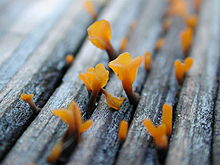Dacryopinax spathularia
| Dacryopinax spathularia | |
|---|---|

| |
| Scientific classification | |
| Kingdom: | Fungi
|
| Division: | |
| Class: | |
| Family: | Dacrymycetaceae
|
| Genus: | |
| Species: | D. spathularia
|
| Binomial name | |
| Dacryopinax spathularia (Schwein.) G.W.Martin (1948)
| |
| Synonyms[1] | |
|
Merulius spathularius Schwein. (1822) | |
Dacryopinax spathularia (syn. Guepinia spathularia) is an edible jelly fungus. It is orange in color. In Chinese culture, it is called guìhuā'ěr (桂花耳; literally "sweet osmanthus ear," referring to its similarity in appearance to that flower). It is sometimes included in a vegetarian dish called Buddha's delight.[2]
The basionym of this species is Merulius spathularius.
Description[]
The fruit bodies of Dacryopinax spathularia are spatula-shaped, usually 1–1.5 cm (0.4–0.6 in) tall and between 0.5–3 mm wide. The color is orange when fresh, but it darkens to orangish-red when dry. The spore deposit is white. Its spores are ellipsoid, smooth-surfaced, hyaline (translucent), and measure 7–10 by 3–4 μm. It has forked, four-spored basidia that are 25–35 by 3–5 μm.[3]
Habitat and distribution[]
A saprobic species, D. spathularia grows on rotting wood; it has even been reported to grow on polyester rugs.[4] It is widely distributed in Asia, and also known from Hawaii, Europe, South America and eastern Africa.[4] It is also found in woodland areas of Texas and North America.
Edibility[]
Dacryopinax spathularia is edible.[5]
References[]
- ^ "Dacryopinax spathularia (Schwein.) G.W. Martin". MycoBank. International Mycological Association. Retrieved 2014-07-01.
- ^ Meuninck, Jim (2017). Foraging Mushrooms Oregon: Finding, Identifying, and Preparing Edible Wild Mushrooms. Falcon Guides. p. 74. ISBN 978-1-4930-2669-2.
- ^ Zhishu B; Zheng G; Taihui L (1993). The Macrofungus Flora of China's Guangdong Province (Chinese University Press). New York: Columbia University Press. p. 52. ISBN 962-201-556-5.
- ^ a b Hemmes DE; Desjardin D. (2002). Mushrooms of Hawai'i: An Identification Guide. Berkeley, California: Ten Speed Press. p. 79. ISBN 1-58008-339-0.
- ^ Boa E. (2004). Wild Edible Fungi: A Global Overview Of Their Use And Importance To People (Non-Wood Forest Products). Food & Agriculture Organization of the UN (FA. p. 134. ISBN 92-5-105157-7.
External links[]
| Wikimedia Commons has media related to Dacryopinax spathularia. |
| Wikispecies has information related to Dacryopinax spathularia. |
- Dacrymycetes
- Edible fungi
- Fungi of Asia
- Fungi of Europe
- Fungi of South America
- Fungi of Colombia
- Fungi described in 1822
- Taxa named by Lewis David de Schweinitz